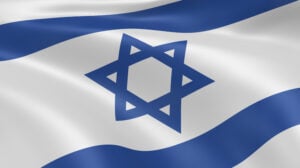The Star of David is a six-pointed star made up of two equilateral triangles superimposed over each other. From its place on Israel’s flag and its incorporation into the architecture of synagogues (both old and new), the Star of David is the most recognizable Jewish symbol today.
The Star of David is sometimes called “the Jewish star” by those unfamiliar with its official name. In Hebrew, it is known as the Magen David, which means the “Shield of David.” While this name leads many to think that the symbol must have been on the shields of King David’s army, the origins of the Star of David aren’t so simple. Read on to learn more about how this symbol came to be associated with Judaism.

History
The origins of the Star of David in Judaism are unclear; however, evidence suggests that the hexagram shape began to appear in ancient Jewish history as a decorative motif. Its Hebrew name, Magen David, suggests that the Jewish symbol originates from the shield of the ancient army led by King David. However, no archaeological evidence has been discovered that can validate this, and no explicit descriptions of a hexagram on the shields of King David’s army appear in the Torah or Tanakh.
There are several instances in the Torah, Tanakh, Talmud, and other traditional texts where the Magen David is mentioned, as representing God’s protection of David and the Jewish people. In fact, God is sometimes referred to as the “Shield of David” in Jewish prayer books.
The Magen David may also have Kabbalistic roots, as the star was discovered on a tombstone in southern Italy from the third century. However, writings by Kabbalists indicate that the usage of the Star of David in mystical communities is unrelated to its possible usage as a symbol adorning the shield of David.

Decoration
The earliest known uses of the Star of David are decorative, including an excavated seal (sixth century B.C.E.), and an arch dating back to the third or fourth century that was found on a synagogue in the Galilee. Similarly, the hexagram adorns various early Tanakh manuscripts, such as the famous Leningrad Codex (1008 C.E.). The use of the Star of David as a decorative symbol continues today, as many synagogues across the world incorporate the hexagram star motif into their architecture, logos, and more.

Protection
In the Middle Ages, the six-pointed star became more closely associated with Jewish mysticism and magic. Ancient Jewish texts mention a shield in this shape used by King David when he went into battle and so the hexagram became known in popular legends as the “Shield of David”; however the true history of the shield is less clear. Later legends connect this star symbol with a ring used by King Solomon to control evil spirits, also earning it the nickname the “Seal of Solomon.”
Later on, Jewish mystics have utilized hexagrams that we now identify as the “Star of David” as symbols of protection, often inscribing them on the outside of mezuzot and on amulets.
Identity

In 1354, the Jews of Prague were granted the right to of display their own flag on certain occasions. They chose as their flag one with a large six-pointed star in its center. From there, the Star of David spread to other Jewish communities, eventually reaching Eastern Europe. By the 17th century, there was a popular practice to put the Star of David on the outside of synagogues to identify them as Jewish houses of worship in much the same way that crosses identified Christian churches.
Today, the Star of David has become a popular symbol of Jewish identity and pride, and can be found on all sorts of modern flags, emblems, synagogues, Jewish community buildings, Judaica and home décor, and Jewish jewelry, most famously as Star of David necklaces and pendants. (To see our favorite Star of David jewelry pieces, check out this Top 15 guide!)
In the State of Israel
The Star of David as a symbol of the Zionist movement predates the establishment of the State of Israel. The six-pointed star was the emblem of the First Zionist Congress in 1897, and appears on the center of the Israeli flag – including versions of it that appeared before the formal establishment of the state. However, while the star is a widely recognized symbol, it is not the official symbol of Israel; that honor is reserved for the seven-branched menorah, which can be found on Israel’s coat of arms, Israeli passports, and other national logos and landmarks.
This doesn’t make the Magen David any less important! The use of the symbol by the army, sports teams, synagogues, the national ambulance service Magen David Adom, and many other institutions and organizations has only strengthened the Star of David’s significance as a symbol of Israel, Judaism, and the long history and unique identity of the Jewish people worldwide.

In other cultures
The Star of David as we know it hasn’t always been solely associated with Judaism. Even today, the six-pointed star can be found as a symbol in religious communities including Jainism, Buddhism, and Hinduism. However, when the hexagram appears in these religions, it is often somewhat different in appearance than the version commonly associated with Judaism today. Many also confuse five or seven pointed stars that are common across the East as the Star of David, too.
The Seal of Solomon, which resembles the Magen David, is a popular symbol in Islam that has been found on tombs, coins, and other ancient artifacts throughout the Middle East and the Mediterranean regions. While much rarer in modern times, the Star of David also appears as a symbol in Christianity, especially on stained glass windows and in churches associated with the Latter-Day Saints sect. It also has a different name in Christianity: the “Star of Creation.” In fact in Medieval times, the six-pointed star was much more commonly found in Christian churches than in Jewish houses of worship.

Since the Magen David is a type of hexagram — which, truth be told, is a fairly common shape — many historians believe that the star developed in significance independently among different cultures and religions over time. The Star of David became more singularly a symbol of Judaism in World War I, when it was used on the gravestones of Jewish Italian soldiers.
The Star of David today
The establishment of the modern State of Israel in 1948 and its use of the Star of David in the center of the official Israeli flag has only strengthened the world’s association of the Star of David with the Jewish people. It has come to be the most universally recognizable symbol of Judaism and the Jewish people around the world, and has thus also become a common symbol of Jewish pride and identity, commonly appearing on jewelry, Judaica, clothing, and other personal expressions of Jewishness.













